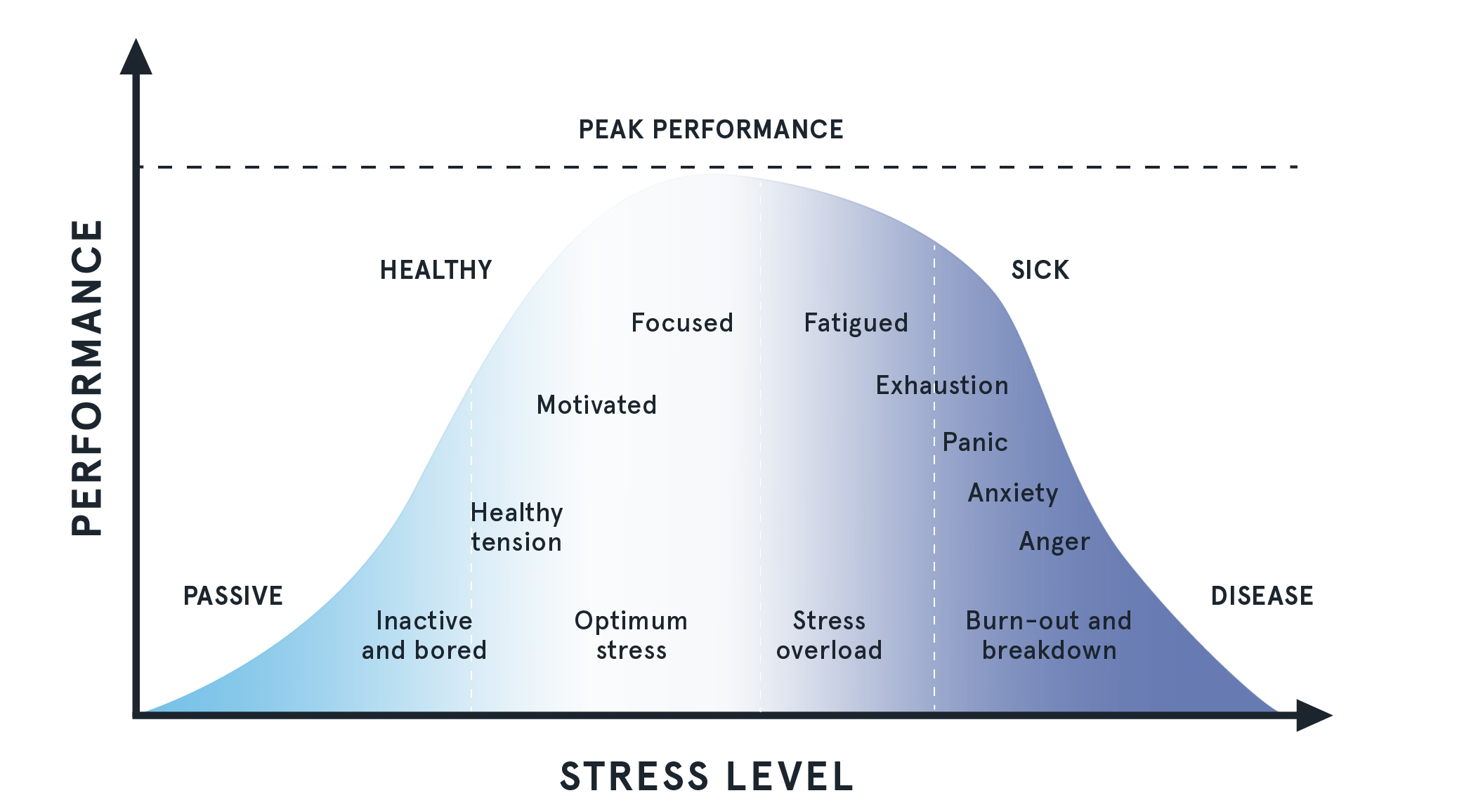Although it might be hard to believe, occasional stress and anxiety are normal and even important parts of life.
Manageable stress, however, is very different from chronic stress. Chronic stress has a directly negative effect on your overall well being. It affects your brain health (to the point where it can alter brain structure), your emotions and hormone production, your mobility, and can even weaken your immune system and spur the development of chronic diseases.
Needless to say, it is essential that your clients are able to manage stress effectively to ensure long-term health. Due to different circumstances, you might notice that your clients are having difficulty managing stress and anxiety. It might be affecting their productivity and their willingness to exercise and eat balanced meals, and they may be unwilling to follow through with commitments.
In this article, we review some of the science behind stress, provide information on how to explain to your clients what is going on in their body, and suggest several research-backed ways they can manage their stress in a healthy manner.
Different Types of Stress
In general, we can categorize stress into two types: psychosocial (mental) stress and physiological (physical) stress.
Physiological (physical) stress refers to an unpleasant or painful experience associated with potential damage of the body tissue or a threat to your life. Conditions like pain, hunger, and oxidative stress caused by exposure to toxins are causes of physiological stress.
Psychosocial (mental) stress results from situations of social threat, like social exclusion, stress related to achievement, negative emotions, and goal-oriented performance. If psychosocial needs aren’t met, psychosocial stress can result. Often, this is referred to as anxiety.
Both types of stress are linked and can occur simultaneously. For example, being diagnosed with diabetes can cause psychosocial stress, and the disease itself poses a source of physiological stress on the body.
In this article, we will focus primarily on psychosocial stress, since physiological stress must often be treated or managed in a medical setting.
The Science Behind the Stress Response
The stress response is exactly what it sounds like; it is the way your body reacts to a stressor, which might be a threat, a deadline, uncertainty, or endless others.
Here is the stress response summarized in six steps.
- Through your eyes and ears, you perceive the source of stress coming your way. This information is sent to the amygdala of the brain.
- The amygdala sends a distress signal to the hypothalamus, which is above the amygdala. The hypothalamus is like a command center, and it is responsible for communicating what is occurring or what is about to occur to the rest of the body.
- The hypothalamus communicates to the body that a threat is on the way by way of the autonomic nervous system, which controls involuntary bodily functions like breathing, blood pressure, and energy production. At this point, a burst of energy is made available to the cells.
- The hypothalamus also sends a signal to the adrenal glands to pump adrenaline (epinephrine) into the blood. Adrenaline will make the heart beat faster to push oxygen-filled blood to the cells, the eyes to dilate, the senses to become sharper, and the lungs to breathe faster.
- When the adrenaline surge subsides, and if the threat is still present, the stress-response system, called the HPA axis, is activated. The HPA axis causes the hypothalamus to release the corticotropin-releasing hormone (CRH). CRH, through a series of reactions, will spur the release of cortisol.
- Cortisol, commonly known as the “stress hormone,” will keep your body alert and revved up. When the perceived threat is no longer present, cortisol levels fall and the parasympathetic nervous system activates “the brake,” which dampens stress response.
With chronic stress, your body is unable to activate the brake, so cortisol levels are constantly high. This has numerous effects on the mind and the body.
Common Causes of Stress
Some common causes of stress include:
- Forced or mandatory isolation (such as with the COVID-19 pandemic)
- The death of a loved one
- Divorce
- Job loss
- Financial problems
- Moving to a new home
- Current chronic illness
- Injury
- Uncertainty about the future
- Too many commitments
- Expectations they feel like they cannot meet
- Others
Identifying the cause (or causes) of stress are important to finding solutions, since, in some cases, the stressor can be reduced, or cause-specific coping techniques can be adopted.
Negative Effects of Chronic Stress
Too much stress makes us sick. If your client is under chronic stress, he or she might have some of the following physical symptoms, including:
- Headaches
- Stomach and digestive issues
- High blood pressure
- Chest pain
- Lowered libido
- Sleep problems
- Depression
- Panic attacks
If chronic stress is not managed in a timely manner, in the long term, it can increase your risk of developing different types of cancer and heart disease. For these reasons, and to simply be able to live a happy productive life under different circumstances, it is important for your clients to adopt techniques that allow them to manage stress effectively.
Learn How to Become a Certified Holistic Health Coach Online

Can Stress Be Healthy?
From a biological perspective, stress is required for living beings to adapt to new situations, develop, and respond appropriately.
To help our clients understand this, we can think of how stress can be healthy on two levels: on a biological level and on a personal development level.
Example 1: Stress for Biological Adaptation
Living beings, especially humans, have the capacity to adapt to different environments for basic survival. Adaptation is the result of stress on the body and mind. This type of stress is what we referred to above as physiological stress.
Let’s consider this example: If we decide to take a long hike up a high mountain, we may find that it starts getting a little hard to breathe. This is because the oxygen density is thinner at higher altitudes. Your body will naturally produce stress hormones, which will lead to you breathing a bit faster and a bit deeper (you might not even notice!). This helps you get the oxygen you need in your body in the short term. This example shows how stress can help you survive, which is, of course, essential for your health.
Example 2: Stress for Personal Development
You are getting ready to give your first-ever webinar titled “Tools for Staying Healthy While at Home” that will be viewed by hundreds of people. As the day gets closer, you begin to stress out. You are worried about not being clear or fumbling during your presentation. That stress motivates you to review your materials and presentation several times, do all the platform tests to help avoid any technical glitches, and practice the presentation with a friend. When the time comes to give the webinar, you’ve grown a lot more confident knowing that you have done all that is in your hands to prepare for the webinar.
In short, the initial stress caused by giving your first-ever webinar moved you to prepare better. As a result, you were more confident when the time came to present.
The Difference between Healthy and Unhealthy Stress
Stress and anxiety are normal and even necessary up to a certain point. However, if stress gets to be too much for your body or mind to handle, it is no longer helping you be healthy and productive.
This relationship is best described by the Yerkes-Dodson Law.
The Yerkes-Dodson Law describes how performance increases or improves with increased physiological or mental stress but only up to a certain point. When stress levels are too high to manage, performance decreases. This can manifest itself on a physical level as well. When someone is too inactive and bored, it results in passive and sedentary lifestyles. On the other hand, chronic physiological or mental stress can result in burnout and illness.

6 Healthy Ways to Help Your Clients Cope with Stress
People can experience stress due to enclosure, big life changes, losing an income, or preparing for an upcoming interview. People respond to stress in different ways depending on their personality.
Some usual responses to stress that are not conducive to physical and mental health and well being include:
- Snacking or grazing when you are not hungry
- Eating lots of processed foods
- Zoning out and streaming shows and movies for hours on end
- Shutting yourself off from loved ones
- Lashing out at friends and family
- No longer caring about work, family, or your health
- Spending hours on social media
- Sleeping all-day
There are many alternatives to coping with stress and anxiety that are conducive to wellbeing and health.
Some of these include:
Yoga
There are more studies on the effect yoga has on stress and anxiety than any other exercise type. This is likely in part because of the mental and spiritual components of the practice that promote mindfulness, being in tune with your body, and making a conscious effort to relax different muscles in the body.
According to this study published in the West Indian Medical Journal, “In yoga, physical postures and breathing exercises improve muscle strength, flexibility, blood circulation, and oxygen uptake as well as hormone function.”
A review of studies found that the majority of studies reported a significant decrease in stress and/or anxiety symptoms when a yoga regimen was followed regularly.
Even if your client has not practiced yoga before, you can suggest some basic yoga poses and movements that could benefit your client. Here is an article on different types of yoga for beginners.
Cardio or Weightlifting
While it is well-established that exercise helps to reduce stress and anxiety, there is very limited information about the relationship between exercise intensity and stress relief. This might be due, in part, to personal preferences and training levels.
Depending on what your client’s normal exercise routines look like, they may find relief in being able to use up bursts of energy with exercises like weightlifting and cardio. These types of exercise might be most effective if your client is frustrated, angry, or panicky since these emotions are often linked to excess energy.
These exercises might be effective if your client has reported unintentionally lashing out at people or having the desire to break things.
Make sure to encourage your clients to make controlled movements and manage speed to avoid injury.
Mindfulness Meditation
Mindfulness meditation is a practice that helps to increase awareness of your body, how you are feeling, and regain control over your emotions and constructive focus. With mindful meditation, the focus is on holistic wellness. From this point of view, stress has roots in and directly affects the mind, body, and spirit.
Research shows that adopting a mindful meditation practice regularly reduces stress, increases a sense of control, and increases spiritual experiences.
Additionally, not only can mindful meditation reduce stress, but it can also improve overall brain health and cognition, including increased attention, concentration, mood, and reduced fatigue.
Practice Sleep Hygiene
We all know we should be getting between seven and eight hours of sleep a night for optimum health, but when you are feeling anxious or chronically stressed, even if you are lying down in your bed at an early hour, you aren’t necessarily going to fall asleep right away or sleep through the night.
However, a lack of proper sleep can lead to changes in what is called the hypothalamic-pituitary-adrenal (HPA) axis, causing dysregulation of brain chemicals and an increase in stress. Additionally, stress can cause sleep disorders and sleep deprivation. In short, a lack of sleep and stress can catch you in a vicious cycle.
One of the ways to promote better sleep is by carrying out proper sleep hygiene. Some effective sleep hygiene techniques include:
- Starting a sleep schedule
- Reducing the consumption of caffeine-containing foods and drinks
- Looking at your phone for the last time one hour before you go to bed
- Making sure you are in an entirely dark room
- Avoiding “disruptive” foods close to bedtime, like spicy or high-fat foods.
You can read more about tips on how to implement better sleep hygiene here.
Setting Screen Time Limits
Social media channels and TV can be periodically flooded with depressing news stories, and social media channels can cause your clients to feel imposter syndrome or extreme social pressure to fit a certain mold.
While it might be important to your clients to stay up-to-date with the latest news and the goings-on in their network’s lives, encourage them to set time limits for their digital leisure screen time. The rest of the day, they can turn off notifications, or they can download an app to prevent them from opening other apps during certain times of the day.
Intuitive Eating + Improving Gut Microbiota
Research has shown that intestinal microbiota (healthy gut bacteria) is a key player in helping to control the gut-brain axis during stress.
The gut-brain axis refers to the routes of communication between the digestive system and the brain. Studies show that there is a close connection between an unhealthy gut bacteria population and stress-related disorders.
What does this mean for your clients? If your client tends to reach for a bag of chips when they are looking over their finances, it is likely that their eating habits have had a negative impact on their gut microbiota population. This means that they will also be more likely to have an unhealthy response to stress, thus entering a vicious cycle of stress + eating habits that counter health. Over time, the impact on mental health could reach beyond stress and influence the development of neurodegenerative diseases like Alzheimer’s and Parkinson’s disease.
What is the solution? While research about the gut-brain axis is still emerging, there are two key actions that could potentially improve the stress response and promote health at the same time.
First, it is important to fight the urge to stress eat and instead listen to your body and understand what it needs to stay healthy. One of the ways to do this is to implement intuitive eating. Intuitive eating is the approach that there are no foods that are “off-limits,” but instead by learning to understand and listen to our body’s needs, we will start craving foods that promote health. You can learn more about intuitive eating here.
Secondly, it is important to reestablish a healthy gut microbiota population. This can be achieved by eating fermented foods regularly (like miso, yogurt, and kefir) or by taking probiotic supplements. Probiotic supplements are one way to help recreate a healthy gut environment to strengthen healthy communication through the gut-brain axis, thus helping to promote brain health, including a healthy response to stress.
You can learn more about how the gut affects mental health here.
What if Your Client Is Choosing “Unhealthy” Ways to Manage Stress?
Remind clients that, while you want to support them to adopt coping mechanisms that help them deal with and reduce stress in healthy ways, they shouldn’t be too hard on themselves if they find they are falling into some of the “unhealthy” responses above. In times of extreme anxiety or stress, feeling guilty about giving into natural responses can cause even more stress and may even create distance between you and your client.
Instead, help your client recognize that these responses are natural (see Yerkes-Dodson Law curve above). If they find themselves giving into these behaviors, it is likely that they are experiencing stress levels that are seriously affecting their wellbeing.
Next, encourage them to practice some simple calming exercises to try and move them back on the curve. Some may include breathing exercises and visualizations. If you can, perform these exercises with them.
These simple but effective techniques can help them get into a mindset where they are ready to redirect their energy toward carrying out the healthy stress-reducing activities and exercises mentioned above.
AFPA offers a comprehensive and flexible yoga instructor course that can help you achieve your career goals.
Main Takeaways
This article provided an overview of what stress and anxiety are, when they can be useful and when they are not, and techniques for managing chronic stress in a healthy way. Remember that, even if your client has adopted techniques for coping with stress that are not conducive to a healthy lifestyle, it is important to recognize that these are still normal responses. Providing your clients with the tools to enter a mindset where they can redirect their energy toward constructive actions can significantly boost your skills as a health or fitness coach.




